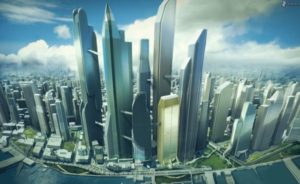
What is a “smart” society? While flights of imagination from science-fiction writers, filmmakers, and techno-futurists involve things like flying cars and teleportation, in practice smart technology is making inroads in a piecemeal fashion, often in rather banal circumstances. In Chicago, for example, predictive analytics is improving health inspections schedules in restaurants, while in Boston city officials are collaborating with Waze, the traffic navigation app company, combining its data with inputs from street cameras and sensors to improve road conditions across the city. A city-state such as Singapore has a more holistic idea of a “smart nation,” where the vision includes initiatives from self-driving vehicles to cashless and contactless payments, robotics and assistive technologies, data-empowered urban environments, and technology-enabled homes.
More broadly, we might define a smart society as one where digital technology, thoughtfully deployed by governments, can improve on three broad outcomes: the well-being of citizens, the strength of the economy, and the effectiveness of institutions.
The potential for technologies to enable smart societies is rising. For example, internet-of-things sensor applications are envisioned to deliver a wide range of services, from smart water to industrial controls to e-health. The market for smart technologies is predicted to be worth up to $1.6 trillion by 2020, and $3.5 trillion by 2026. Surely, given the size of the opportunity, increasing interest among governments and policy makers, and the explosion of relevant technologies, we can start to understand what smart societies are and establish standards and ideals to aim for.
The Fletcher School at Tufts University and Microsoft Digital have launched an initiative to explore this issue, with several questions as the guiding framework:
- What are smart societies, and what are their core components?
- Are there countries that might offer realistic models for such societies?
- Are there patterns of different approaches to smartness reflecting different contexts, histories and societal priorities?
- What are the implications for policy makers, particularly as they consider digital technology — whose applications are growing at an accelerated pace — as a lever for getting to smartness?
To answer these questions, we began with a simple premise: Neither “smartness” nor the technology to be deployed is the end goal. A smart society ought to be defined by a framework that is based on outcomes. Its building blocks are what governments and policy makers aim to provide for their citizens. The technology is just a way to get there.
The next step was to identify potential models for smart societies. A natural group of countries to use as role models was the Digital 5, or D5, nations, representing the most digitally advanced governments in the world. The group comprises Estonia, Israel, New Zealand, South Korea, and the UK. Their objective, as set out by the D5 charter, is to provide the best digital public services and to share practices across these high-performing digital governments. There is a plan to admit more countries to this group as it establishes practices that can benefit countries from across the world.
To set an aspirational but realistic target, we created a benchmark that combines the best attributes of these advanced digital nations. Our hope is that it serves several purposes. First, it sets a standard for policy makers based on what has been demonstrated to be feasible by at least one of the D5 nations. Second, with the benchmark as a composite, no single nation achieves it and yet each of the five countries’ progress toward the ideal can be assessed in terms of performance against the benchmark. If any country intends to close a gap, it can turn to the others to learn about best practices and import knowledge that could help it get to the benchmark. The benchmark, therefore, is a tool for policy makers, technology innovators, and others to evaluate progress and prioritize the gaps, thus enabling a dialogue among the key actors and a plan for action.
By: Bhaskar Chakravorti


















